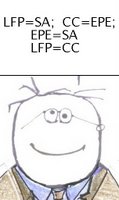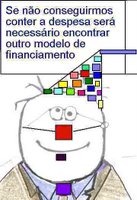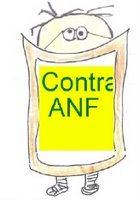Relatório "Um Futuro para a Saúde"
A Fundação Calouste Gulbenkian constituiu uma Comissão encarregada de “criar
uma nova visão para a saúde e cuidados de saúde em Portugal, descrever
o que é que isto significaria na prática e estabelecer a forma como poderia ser
realizado e mantido.” link
Comissão formada por Lord Nigel Crisp (presidente), Donald Berwick ,Ilona Kickbusch, Wouter Bos, João Lobo Antunes, Jorge Soares e Pedro Pita Barros
O relatório da referida Comissão deixa-nos vinte recomendações para cumprir o fim ambicioso de transformar «a saúde dos portugueses, objecto de notáveis progressos nas últimas décadas, que nos posicionam em lugar de reconhecimento internacional e que constitui a marca mais positiva dos 40 anos do nosso regime democrático.»
Com base neste almanaque de brilhantes ideias, a FCG lança mãos à obra com três iniciativas ambiciosas:
- Reduzir
a incidência das infecções hospitalares – baixar as taxas actuais para metade em
3 anos, em 10 hospitais.
- Suster o crescimento da incidência de diabetes – em 5 anos, evitar que 50 000 pessoas desenvolvam a doença.
- Ajudar o país a tornar-se um exemplo na saúde e no desenvolvimento dos primeiros anos de infância – com melhorias quantificáveis nos indicadores de saúde e bem-estar das crianças.
A FCG admitiu que, em conjunto, estes Desafios possam poupar ao SNS entre 1% e 3% da despesa anual.
- Suster o crescimento da incidência de diabetes – em 5 anos, evitar que 50 000 pessoas desenvolvam a doença.
- Ajudar o país a tornar-se um exemplo na saúde e no desenvolvimento dos primeiros anos de infância – com melhorias quantificáveis nos indicadores de saúde e bem-estar das crianças.
A FCG admitiu que, em conjunto, estes Desafios possam poupar ao SNS entre 1% e 3% da despesa anual.
Aguardemos o destino das recomendações depois do ribombar da festa.
drfeelgood
Etiquetas: s.n.s


























1 Comments:
Background
Despite the considerable injury burden attributable to falls at home among the general population, few effective safety interventions have been identified. We tested the safety benefits of home modifications, including handrails for outside steps and internal stairs, grab rails for bathrooms, outside lighting, edging for outside steps, and slip-resistant surfacing for outside areas such as decks and porches.
Methods
We did a single-blind, cluster-randomised controlled trial of households from the Taranaki region of New Zealand. To be eligible, participants had to live in an owner-occupied dwelling constructed before 1980 and at least one member of every household had to be in receipt of state benefits or subsidies. We randomly assigned households by electronic coin toss to either immediate home modifications (treatment group) or a 3-year wait before modifications (control group). Household members in the treatment group could not be masked to their assigned status because modifications were made to their homes. The primary outcome was the rate of falls at home per person per year that needed medical treatment, which we derived from administrative data for insurance claims. Coders who were unaware of the random allocation analysed text descriptions of injuries and coded injuries as all falls and injuries most likely to be affected by the home modifications tested. To account for clustering at the household level, we analysed all injuries from falls at home per person-year with a negative binomial generalised linear model with generalised estimating equations. Analysis was by intention to treat. This trial is registered with the Australian New Zealand Clinical Trials Registry, number ACTRN12609000779279.
Findings
Of 842 households recruited, 436 (n=950 individual occupants) were randomly assigned to the treatment group and 406 (n=898 occupants) were allocated to the control group. After a median observation period of 1148 days (IQR 1085—1263), the crude rate of fall injuries per person per year was 0·061 in the treatment group and 0·072 in the control group (relative rate 0·86, 95% CI 0·66—1·12). The crude rate of injuries specific to the intervention per person per year was 0·018 in the treatment group and 0·028 in the control group (0·66, 0·43—1·00). A 26% reduction in the rate of injuries caused by falls at home per year exposed to the intervention was estimated in people allocated to the treatment group compared with those assigned to the control group, after adjustment for age, previous falls, sex, and ethnic origin (relative rate 0·74, 95% CI 0·58—0·94). Injuries specific to the home-modification intervention were cut by 39% per year exposed (0·61, 0·41—0·91).
Interpretation
Our findings suggest that low-cost home modifications and repairs can be a means to reduce injury in the general population. Further research is needed to identify the effectiveness of particular modifications from the package tested.
The Lancet, 23 September 2014
Mais uma acção na área da prevenção a juntar ao almanaque.
As autarquias deviam promover e ajudar a financiar estas pequenas intervenções nos domicílios dos mais idosos.
Enviar um comentário
<< Home